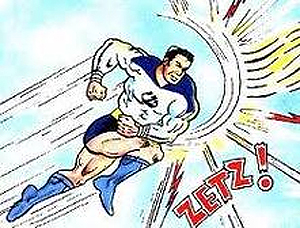By Bruce S. Ticker

PHILADELPHIA –Al Wiesner attended Hebrew school in Philadelphia since he was 4 or 5, was influenced by grandparents who were deeply religious and his mother was active in the local synagogue. He even spoke Yiddish at home.
“I got to know it so well they couldn’t talk in front of me. So they spoke Hungarian,” he recalled.
His Jewish identity was forged so early that he felt left out when he became enamored of cartoon superheros. He had Superman and others, but no superhero for the Jewish people.
“There were no Jewish characters,” he said.

Since nobody else would create a Jewish superhero, the task was left to Wiesner. Decades later, after studying art, serving in the Air Force, holding a day job as a hairdresser and raising a family, Wiesner gave the world – drum roll, please – “Shaloman.”
After 22 years and more than 40 issues, the super-human Shaloman has saved Purim, Passover and Chanukah and confronted baddies who took an airplane’s passengers hostage and seized the Statue of Liberty. He has served President Derek Montana – who coincidentally resembles President Obama – and taken on a villain much like Osama bin Laden.
If you are in trouble and need Shaloman to rescue you and your friends and save Israel, if not the world, all you need do is cry out: “Oy Vey!”
Shaloman can be counted on to arrive in short order.
The Shaloman series aims to relate an exciting tale while simultaneously teaching Jewish children in particular about Jewish traditions. “They’re educational and they’re entertaining,” Wiesner, 80, said.
The concept of Shaloman finally jelled for Wiesner in the early 1980s. Coincidentally, it was around that time, 1981, when “History of the World: part 1” – directed by and starring Mel Brooks – was released.
Brooks announced at the end of the film its forthcoming sequel, “Jews in Space.” After 29 years, Brooks has yet to make that film. We can think of a way for Brooks and Wiesner to partner together. More on that later.
His wife at the time, Susan, now deceased, encouraged him. “She said if you want to do it, look into it,” he recalled.
Shaloman was often challenged by arch-villain Dr. Treif, a play on words for anything that is not kosher. He inadvertently resembles one of Wiesner’s former art teachers.
“I try to come up with the face of a villain,” he explained. “Your mind races back to things you know. I had no intention of drawing anyone.”
The first edition appeared in 1988, but it took a few years to gain a foothold in the cartoon-publishing world. From then on, he usually printed 3,000 copies of each issue and sold 2,000 of them, primarily in Judaica stores and synagogue gift shops.
A group of children at the Princeton Jewish Center, a conservative synagogue, formed a Shaloman fan club. A set of books containing the cartoons are kept at Ohio State University and Michigan State University, he said.
His parents were young children when their parents took them from Hungary to the United States.
Wiesner recalled growing up in North Philadelphia, West Philadelphia and the more suburban-like Northeast section of the city, where he belonged to the Oxford Circle Jewish Community Center, a conservative shul, for many years. He moved to Warminster in Bucks County three years ago.
He worked as a hairdresser while keeping in practice as a cartoonist after hours. He has three children, two stepchildren and six grandchildren. “When I make a new book, they (his grandchildren) want it right away. They love it,” he said.
A highlight of his career was basing a Shaloman issue on his first trip to Israel where he attended a Bar Mitzvah ceremony at Masada. This issue, “The Bar/Bat Mitzvah,” describes the bar/bat mitzvah rites and takes us on a cartoon tour of Israel. In between, Shaloman confronts an Entebbe-like crisis.
Wiesner transferred images of iconic Israeli sites to comic book form by sketching them when he visited there and taking photos. Those sites included the Western Wall, Mt. Scopus, Hadassah Hospital, a narrow street in Jerusalem, the rabbinical tunnel, Yad Vashem, a kibbutz, the Tank Corps Memorial at Latrun (site of a battle in 1948), the Diaspora Museum at Tel Aviv University and the Golan Heights.
He also sketched the faces of the bar mitzvah boy, his relatives and many others, and their cartoon images appeared in this issue. In particular, he preserved for posterity the images of his guide, Hillel, and his driver, Albert.
In late July, he flew into San Diego to participate in Comic-Con International, which attracted important figures in the comic book world such as Stan Lee and Brian Michael Bendis. He said he met Lee and occupied a booth behind Stan Frieberg and next to Jerry Robinson.
He also posed with Superman and Batman. Well, they claimed to be these superheroes.
Wiesner notified us that he will spend the coming months preparing his next and probably last issue of Shaloman. He hopes to present it to the world early next year, but he would only hint as to what it is about.
Key words: the future of the Jewish people, anti-Semitism and outer space.
Hmmm. Maybe Mel Brooks will be inspired by Shaloman’s final venture as source material to finally produce that long awaited sequel, “Jews in Space.”
*
Ticker is Philadelphia bureau chief for San Diego Jewish World